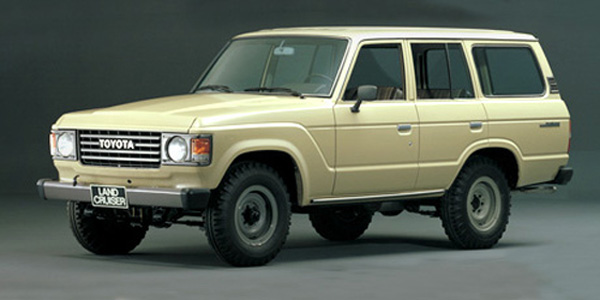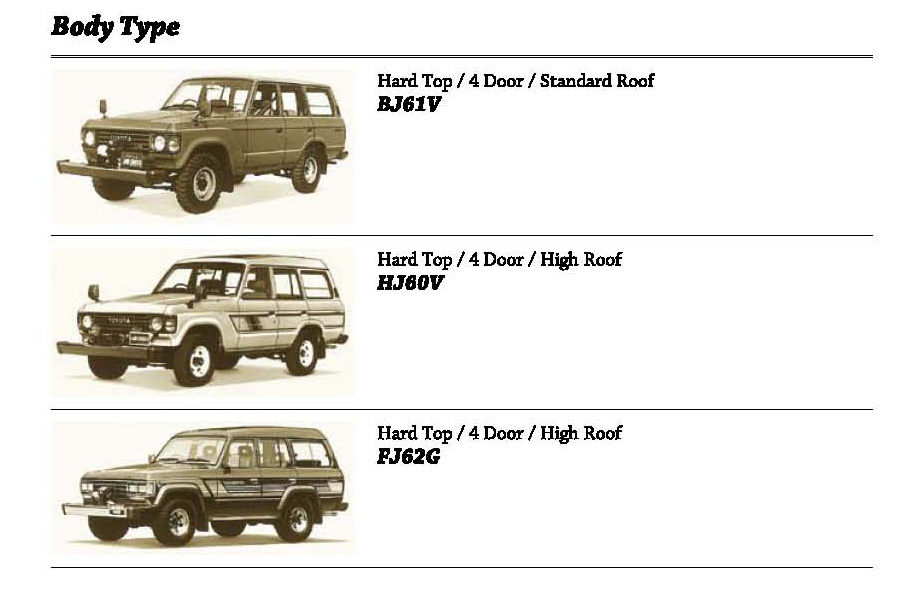
The transition from a workhorse to an RV (Recreational Vehicle), the debut of the 60 series changed the general opinion of 4WD vehicles together with the addition of the luxury GX grade. This sales strategy also spread across to the 40 series of this time.
In 1979 a new 3,168cc 2B-type engine was added to the BJ40-series, at which point the BJ40 became the BJ41 and the BJ43 evolved into the BJ44. The 60-series made its appearance the next year in 1980.
Under the supervision of Chief Engineer Hiroshi Ohsawa in 1976 planning began for the next generation of the 50-series Land Cruiser. The first thing that was required was an expansion of the body size. In order to compete in the American market, and against rival vehicles like the Land Rover, something more was needed that went beyond what the FJ55V had to offer. It had to have more of the feel of a passenger car type station wagon, with a softer luxury touch in the interior and a more comfortable ride. The problem was what to do with the suspension. An independent suspension was considered, however this idea was rejected in favor of the existing rigid leaf springs of the FJ55V Land Cruiser, to ensure that it lived up to its name as a vehicle that was highly reliable on whatever road you might take it anywhere in the world.
Eventually Mr. Ohsawa’s responsibilities shifted to the 4 Runner 4WD, the job of Chief Engineer for the 60-series Land Cruiser passed to Iichi Shingu, who saw it through to its debut in 1980.
When the Land Cruiser 60 made its debut, in addition to the 2F-type gasoline engine in the FJ60 and the BJ60 was added to the lineup that had a 3,431cc 3B-type diesel engine that was larger than the 2B. Since the FJ55V era, the demand in Japan had increased for a long model diesel-powered vehicle that was inexpensive to maintain, and the 60-series Land Cruiser was created to meet this demand.
A minor change was introduced in 1982. The major feature of this change was the appearance of the HJ60 with a 6-cylinder 3,980cc 2H-type diesel engine. Not only was the engine large, but the HJ60 came with a high-roof body, a 5-speed transmission, electric moon roof, remote control mirrors, and other luxury features. The FJ and BJ evolved from the 60 to the 61-series, and there was a luxury model similar to the HJ added to the BJ61. The first grade ever was created for the Land Cruiser, the GX to distinguish it from the standard model. Moreover, to comply with emissions control regulations, the 3B engine became standard for the entire BJ40-series, and the BJ42 and BJ46 debuted.
In 1984 the first full model change in 29 years (including the 20-series) was made on the 40-series, and the Land Cruiser 70-series was born. At the same time, the 60-series gained a 2H-type engine matched with an A/T, the first for a cross-country type 4×4 in Japan; and the FJ62 debuted with a 6-cylinder 3,955cc 3F-type engine. In addition, the 3F-type engine was made lighter and more compact in an effort to reduce the volume of emissions, while at the same time its output was increased by 15PS to 155PS/4,200rpm, and the engine gained greater fuel efficiency.
The FJ55V was followed by the 60-series, with which the Land Cruiser took on a body width of 1,800mm, and a more spacious interior in the process.
Having pursued the styling of the station wagon, the separate front fender and hood that had continued since the first generation of the Toyota BJ was replaced with a unified press line, still retaining the old image of the Land Cruiser.
Because the side frame on the FJ55V had already been given a strong ladder frame with a completely enclosed structure, on the 60-series the improvements were limited to minor structural changes and an increase in size. The changes were made in the cross members, particularly in the length and positioning. It was necessary to expand the axle tread to balance the larger body, and because there had also been a demand to make the interior more spacious and comfortable.
The newly developed 3B-type diesel engine was the first diesel engine to be mounted in a long model diesel engine. The cylinder bore of the 2B-type engine that had been mounted in the BJ41/44 was widened by 4mm, which increased the piston displacement by 263cc, bringing it up to 3,431cc. The structure of the 2B-type and 3B-type engines was essentially the same, but the compression ratio in the 3B-type was reduced from 21 to 20, increasing the performance specs slightly by an additional 5PS/2kgm. In 1983 the 3B-type engine was subject to further modifications under stricter emissions regulations, and when the change came from the BJ60 to the BJ61, the fuel injection pump arrangement changed from a linear to a distributed type arrangement, and the output characteristics became milder.
The 2H-type was the first 6-cylinder diesel engine to appear in the Land Cruiser series. It had a different number of cylinders than the B-type, but the sub-combustion chamber was a swirl type just like the 3B-type. The powerful torque delivery of the 2H engine at low speeds was strong enough to activate the high-speed final gear, making it easier to drive on highways.
The 2F-type gasoline engine that was inherited from the 50-series had changes made to the crankshaft, and the piston stroke decreased by 6.6mm. In the later phase of the 60-series with Electric Fuel Injection (EFI) came further improvements in both power and fuel consumption.
The instrument panel on the early model 60-series had a resinous pad with steel panels. The meter panel was an independent unit, retaining the image of the utility car, though the interior of the car had full trim and looked much like that of a passenger car. This was quite unlike the FJ55/FJ56.
The 60-series underwent a number of minor changes. In time it took on power windows and A/T, as well as other luxury trimmings. The resinous pad area was increased on the instrument panel as a safety precaution against crashes, and the seats were changed to a sport-type design.
The FJ62G was mounted with a 3F-type gasoline engine. It was a station wagon with a third seat. In order to climb into the third seat, you first had to fold forward the second seat. Thanks to the high-roof spec, the interior of the vehicle looked quite spacious, but there was not much legroom.
The third seat was roomy, but when it was not in use it would be folded up the right and left, which rather limited the available luggage space. One concern was that when the third seat was folded up it tended to block part of the rear view, creating a blind spot on the right and left sides.
The in-line 6-cylinder 2H-type diesel engine was a naturally aspirated type with a swirl type combustion chamber in the cylinder head. With a piston displacement of 3,980cc, it produced 105PS/25.5kgm.
The 12H-T-type engine was a direct-injection turbo diesel engine based on the 2H-type. In 1985 it was added to the lineup with the HJ61V. With a piston displacement of 3,980cc, it produced 135PS/32kgm.
The 2F-type and 3F-type are from the same engine series, but the 3F was an overall improved version, lighter in weight and more compact. It had an engine displacement of 3,955cc, and produced 145PS/28kgm.
The suspension in the 60-series had a series of improvements made for the sake of better riding comfort. With the minor change in 1987, the suspension was softened by reducing the number of thick springs while keeping the same number of springs overall. The spring rate in the front was unchanged at 4.3kgm, but it had other improvements made.
The rear leaf springs were 100mm longer than those in the front, and had a spring rate about 30% higher. As the 60-series came to be used more and more as a passenger car, this spring rate was gradually reduced. With the release of the HJ61V in 1987, the front and rear spring rate had dropped to about 10%.


You must be logged in to post a comment.